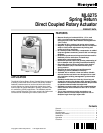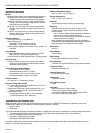
63-2493—1
11
ML6275 SPRING RETURN DIRECT COUPLED ROTARY ACTUATOR
CHECKOUT
The ML6275 Direct Coupled Actuator can be checked out
either directly or by using a controller.
Important
When power is interrupted, the actuator returns to
the normal starting position using the spring
mechanism. When power is restored, the controller
input will not operate the actuator until the spring is
fully wound and locked. The spring winding process
takes approximately 100 seconds, depending on the
number of degrees of spring return remaining at
power interrupt (eg, 10
°
of spring return remaining
takes ten seconds). (If the actuator is not in the
closed position, it will run to the closed position while
the spring is winding.) Once the spring is locked in
its fully wound position, the actuator responds to
inputs across the red-to-blue or red-to-yellow
leadwires.
Direct Checkout
1. Mount the actuator for the required application (either
cw or ccw rotation to open the damper).
2. Check the damper position and make sure that 24 Vac
is present on the red and black leadwires.
3. Make sure the actuator spring is fully wound and locked
by applying power for at least 100 seconds.
4. Connect 24 Vac to the appropriate leadwires (red to
blue or red to yellow) to move the damper to the
opposite position. The ML6275 should drive the
damper.
5. If the actuator does not run, verify that the actuator is
properly installed for either cw or ccw
rotation.
6. If the actuator operates in the opposite direction than
desired, reverse the blue and yellow leadwires.
7. If the actuator is correctly installed and still does not
run, replace the actuator.
Controller Checkout
1. Adjust the setpoint of the controller to call for cooling.
Observe the actuator.
2. If the damper is closed, it should begin to open.
3. If the damper remains closed, move the setpoint of the
controller farther below the room temperature.
4. If the damper still does not move, check for the
presence of 24 Vac in the input.
5. Make sure the actuator spring is fully wound by
applying power for at least 100 seconds.
6. If 24 Vac is present and the actuator does not operate,
reverse the controller leadwires to determine if the
device was miswired.
7. If the wiring is correct and 24 Vac is present on the
input terminals but the actuator does not run, replace
the actuator.














